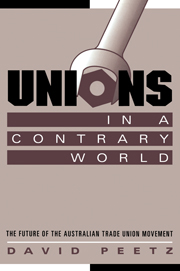Book contents
- Frontmatter
- Contents
- List of Figures
- List of Tables
- Acknowledgments
- Abbreviations
- 1 Patterns and Issues in Union Decline
- 2 Joining and Leaving Unions
- 3 Sympathy for Unions
- 4 Structural Change in the Labour Market
- 5 The Institutional Break in Union Membership
- 6 Within the Workplace
- 7 The Accord and the Post-Accord Industrial Relations Order
- 8 The Future for Australian Unions
- Appendix: Research Methodologies and Data Sources
- Notes
- Glossary
- Bibliography
- Index
4 - Structural Change in the Labour Market
Published online by Cambridge University Press: 05 November 2011
- Frontmatter
- Contents
- List of Figures
- List of Tables
- Acknowledgments
- Abbreviations
- 1 Patterns and Issues in Union Decline
- 2 Joining and Leaving Unions
- 3 Sympathy for Unions
- 4 Structural Change in the Labour Market
- 5 The Institutional Break in Union Membership
- 6 Within the Workplace
- 7 The Accord and the Post-Accord Industrial Relations Order
- 8 The Future for Australian Unions
- Appendix: Research Methodologies and Data Sources
- Notes
- Glossary
- Bibliography
- Index
Summary
There are differences in union density between different industries and occupations; density varies according to the size of the workplace and between the public and private sectors, between full-time and part-time workers, between casual and permanent employees, and between the sexes. Structural change in the labour market might therefore be expected to lead to changes in union density. This chapter examines the influence of these factors on union density, and assesses the extent to which they might be said to be ‘structural’.
Industrial and Sectoral Change
In all countries, there are differences in rates of unionisation among different industries. Workers ‘are more likely to be union members in manufacturing, transport or public administration than in agriculture, (retail and wholesale) trade or financial services’ (Visser 1991:107).
The pattern of industry variation in union density in Australia is comparable to that overseas, but Australia appears to have larger gaps in density between the private and public sectors than many other countries (the average gap in OECD countries being 20 percentage points in 1988). Public-sector unionisation exceeds private-sector unionisation by 55 per cent to 23 per cent in the members survey. Interindustry variation in union density is greater in the private sector than in the public sector. That is, union density tends to be high amongst public-sector workers irrespective of their industry or employment; in the private sector, union membership is more dependent upon employees' industry.
- Type
- Chapter
- Information
- Unions in a Contrary WorldThe Future of the Australian Trade Union Movement, pp. 65 - 83Publisher: Cambridge University PressPrint publication year: 1998

